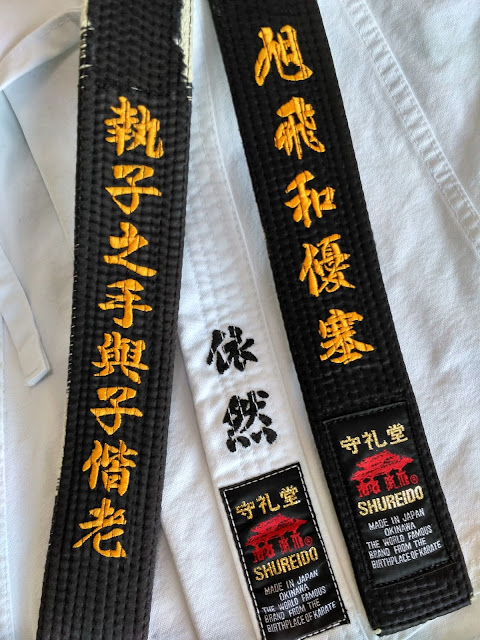On Kyokushin
I am going to start a series of articles about the different trainings I had during different times of my life, living in different countries and training with/under different people.
Everything here are my personal observations, that can be right or wrong, and mainly generalizations.
If I need to be corrected, please use the comments or drop me an email.
Kyokushinkai Karate is the brainchild of Sosai Mas Oyama. It is a hard, tough, painful and extremely demanding way of doing Karate.
It has a nice collection of kata coming from Goju Ryu and from Shorin Ryu that Sosai learnt from Yamaguchi and Funakoshi Senseis mainly, but its core is in kumite (sparring).
(Me in the Tokyo Gymnasium with the first absolute World Kyokushin Kata Champion)
Kyokushin kumite is a continuous experience where you and your friend hit each other as hard as possible during the duration of the match, with no stops other than for penalties or falls and wearing as little padding as possible. Duration of the rounds can be from one to three minutes depending on the experience of the fighters, if it is a test or a tournament.
Usually hits to the front of the body and legs are allowed with hands, elbows, knees, shins and feet, but contact with the face is forbidden for any hand or elbow technique.
This means that KOs are not really common, so the matches usually go the distance with little interruptions.
Throws, sweeps and self-defense techniques are trained but the main focus of the training is in punching the body and kicking the thighs. Bread and butter.
(My friend Machenhao (right) fighting in a tournament)
(My friend Huanghai (left) fighting in the same tournament)
So, yes, punches to the face are forbidden, making it an unrealistic fighting method. I mean, in a fight the first thing you want to do is punch the other guy on the face, right? It is human nature, an instinct. Kyokushin karateka can punch in the face, of course, but can they defend from face punches? If there is no face punch then there is no need to mind the distance between fighters.
Well, let's say that the ban on face punches came after Sosai Oyama realized that broken noses and teeth on a daily basis are not a thing that is desired by many. If I get severely injured during training, what kind of self-defense method am I practicing?
Fighting under these rules makes for exciting competition matches and also has some side effects that I find relevant to self-defense (my main focus). Having to fight without interruptions against someone who is punishing you with his/her hardest blows is an extremely stressful situation. When you are fighting every second feels like an eternity. You are on your own with your pain and your fear.
Been repetitively exposed to this self-defenseless feeling (and I am telling this to you as a Psychologist) will have the effect to make to used to it.
Read it again:
You will get used to scary situations where your well-being is threatened.
How can that be good?
In my idea of Martial Arts the most important thing is to be able to react when attacked. It doesn't matter much if you punch or if you grapple, but you must do something to neutralize the threat on you (or on your family). Been used to be hit will cause you to be used to hit back when under pressure and under stress. Have you already been hit by an attacker? No big deal, I am used to it, and now it is my turn!
(-5º waterfall training on December? No problem!)
Now, what has saved me more than once is that been used to this (extremely) horrible unpleasant feeling is that I can keep my head cold under most situations. Also, my confidence on my fighting ability I believe it shows through my eyes when someone is confronting me. I use that as a deterrent, but carefully so people don't perceive me as the threat.
 |
| (Are you scared?) |
Some of my Kyokushin friends from different groups (IKO1, Kyokushin-kan, IKU, KyoNewaza...) practice under different sets of rules. They also understand that the rules are for tournaments but daily training should be more diverse, as in the original Oyama Dojo.
(Yes, my backpack. Say hello if you see me on the street)
These last years that I have been living in China I have continued my Kyokushin practice in the 唐手到场,沈阳 Tangshou Dojo, in Shenyang.
Under Huang Sensei I learnt many new kata and improved my kumite dramatically. Also, making good friends in the dojo never hurts.
On the last year the dojo moved really close to my workplace so I was there every evening (and some lunches).
The guy behind me with a yellow belt? He is Jack, and also a workmate and a good friend.
(Visiting Sosai's monument in Mitsumine mountain, some years ago)
So, if you are thinking about starting training Kyokushin, just do it! It will make you tough, it will make you fit, it will make you a karateka. Can't go wrong with it!
(The day they made me fight for more than an hour... Man, I was so fit back then!)
So, to close this, if you don't currently practice Kyokushin and there is a dojo nearby, please give it a try. Not just once, but a couple of months minimum, to get a beter idea of how that particular dojo faces training, competitions, self-defense and so on. It may be for you or it may be not.
Chances are that you will love it.












Comments
Post a Comment